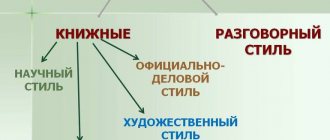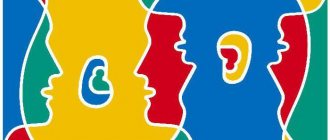There are many varieties of text styles in Russian. One of them is the artistic style of speech, which is used in the literary field. It is characterized by an impact on the reader’s imagination and feelings, the transmission of the author’s own thoughts, the use of rich vocabulary, and the emotional coloring of the text. In what area is it used, and what are its main features?
Features of artistic style
The history of this style dates back to ancient times. Throughout time, a certain characteristic of such texts has developed, distinguishing them from other different styles. With the help of this style, authors of works have the opportunity to express themselves, convey to the reader their thoughts and reasoning, using all the richness of their language. Most often it is used in written speech, and in oral speech it is used when already created texts are read, for example, during the production of a play.
The purpose of artistic style is not to directly convey certain information, but to affect the emotional side of the person reading the work. However, this is not the only task of such a speech. Achieving established goals occurs when the functions of a literary text are fulfilled. These include:
- Figurative-cognitive, which consists of telling a person about the world and society using the emotional component of speech.
- Ideological and aesthetic, used to describe images that convey to the reader the meaning of the work.
- Communicative, in which the reader connects information from the text with reality.
Such functions of a work of art help the author to give meaning to the text so that it can fulfill all the tasks for which it was created for the reader.
Verse and poem
Any topic needs to start with a short excursion into theory, otherwise you and I will simply speak different languages. A poem is a work of art, complete and logical. For example, Lermontov's poem. A verse is a line of a poem. But in common parlance you can use verse and poem interchangeably, which is what we will do.
Styles, types and other fantastic creatures. Most of us confuse the concepts of style, appearance and God knows what else in these verses, so we analyze each meaning separately.
Area of use of the style
Where is the artistic style of speech used? The scope of its use is quite wide, because such speech embodies many aspects and means of the rich Russian language. Thanks to this, such text turns out to be very beautiful and attractive to readers.
Genres of artistic style:
- Epic. It describes storylines. The author demonstrates his thoughts, the external worries of people.
- Lyrics. This example of artistic style helps to convey the author's inner feelings, experiences and thoughts of the characters.
- Drama. In this genre, the presence of the author is practically not felt, because much attention is paid to the dialogues taking place between the heroes of the work.
Of all these genres, subspecies are distinguished, which in turn can be further divided into varieties. Thus, the epic is divided into the following types:
- Epic. Most of it is devoted to historical events.
- Novel. Usually it has a complex plot, which describes the fate of the characters, their feelings, and problems.
- Story. Such a work is written in a small size; it tells about a specific incident that happened to the character.
- Tale. It is medium in size and has the qualities of a novel and a short story.
The artistic style of speech is characterized by the following lyrical genres:
- Oh yeah. This is the name of a solemn song dedicated to something.
- Epigram. This is a poem that has satirical notes. An example of artistic style in this case is “Epigram on M. S. Vorontsov”, which was written by A. S. Pushkin.
- Elegy. Such a work is also written in poetic form, but has a lyrical orientation.
- Sonnet. This is also a verse that consists of 14 lines. Rhymes are built according to a strict system. Examples of texts of this form can be found in Shakespeare.
The types of drama include the following genres:
- Comedy. The purpose of such a work is to ridicule any vices of society or a particular person.
- Tragedy. In this text, the author talks about the tragic life of the characters.
- Drama. This type of the same name allows you to show the reader the dramatic relationships between the heroes and society as a whole.
In each of these genres, the author tries not so much to tell about something, but simply to help readers create an image of the characters in their heads, feel the situation being described, and learn to empathize with the characters. This creates a certain mood and emotions in the person reading the work. A story about some extraordinary incident will amuse the reader, while a drama will make you empathize with the characters.
Genres
If styles are an abstract concept, then genres are more mundane. This means that they logically divide the entire poetic world and there are many of them. Just a few words about the most popular ones.
Oh yeah
Something solemn, sublime and glorifying. “O you who are awaiting...” More pathos to the god of pathos. Add praise to the event, a strict structure and simple wording - and you get the anthem genre.
Ballad
This genre is a little less old than poetry in general. There is a plot that tells about a real or fictional hero and his adventures. For example, about Robin Hood.
Elegy
We see sadness, disappointment, loneliness and a description of the frailty of existence - that means we see elegy.
Song
Probably the most popular genre in all of history. In fact, almost any poem can be sung, but the songs still have a simple rhythm, musicality and choice of words that are easy to sing. And so, any verse sung to music can be called a song. The song about love will already be a romance.
Sonnet
A sonnet is any verse written in the form of “two quatrains and 2 tercets.” There are rules of rhyme and rhythm. And if there are 15 lines in a verse, then this is already a rondo, and the 1st, 9th and 15th lines are repeated here.
Fable
There is imagery, allegory, comedy, necessarily morality, and also a fable - a fairly short work. These are the brightest and most recognizable genres; in fact, there are naturally more of them.
The main features of artistic stylistics of speech
The characteristics of an artistic style of speech have developed over the course of its long development. Its main features allow the text to fulfill its tasks by influencing people's emotions. The linguistic means of a work of art are the main element of this speech, which helps to create a beautiful text that can captivate the reader while reading. Expressive means such as:
- Metaphor.
- Allegory.
- Hyperbola.
- Epithet.
- Comparison.
Also, the main features include the speech polysemy of words, which is quite widely used when writing works. Using this technique, the author gives the text additional meaning. In addition, synonyms are often used, thanks to which it is possible to emphasize the importance of the meaning.
The use of these techniques suggests that when creating his work, the author wants to use the entire breadth of the Russian language. Thus, he can develop his own unique language style, which will distinguish him from other text styles. The writer uses not only purely literary language, but also borrows means from colloquial speech and vernacular.
Features of the artistic style are also expressed in the elevation of emotionality and expressiveness of texts. Many words are used differently in works of different styles. In literary and artistic language, some words denote certain sensory ideas, and in the journalistic style these same words are used to generalize certain concepts. Thus, functional speech styles complement each other perfectly.
Linguistic features of the artistic style of the text include the use of inversion. This is the name of a technique in which the author arranges words in a sentence differently than is usually done. This is necessary in order to give more meaning to a particular word or expression. Writers can change the order of words in different ways, it all depends on the overall intent.
Also in the literary language there may be deviations from structural norms, which are explained by the fact that the author wants to highlight some of his thoughts, ideas, and emphasize the importance of the work. To do this, the writer can afford to violate phonetic, lexical, morphological and other norms.
The features of the artistic style of speech allow us to consider it the most important over all other types of text styles, because it uses the most diverse, rich and vibrant means of the Russian language. It is also characterized by verb speech. It consists in the fact that the author gradually indicates each movement and change of state. This works well to activate the tension of the readers.
If you look at examples of styles of different directions, then identifying the artistic language will definitely not be difficult. After all, a text in an artistic style, in all of the above listed features, is noticeably different from other text styles.
Styles or directions
Style refers to the idea of this poem and the ways in which this idea is conveyed. The name of the style is strictly tied to the time of its origin. Everything here is similar to architecture, because the building is a poem in stone, don’t you think?
Classicism
Just like classical buildings: rectilinear, strict, monumental. The poem as a whole has a structure where each line is a brick, without which the whole structure will fall apart.
Classicism is necessarily based on antiquity, so it appeared in Europe in the 16th century, and in Russia a little later - in the 18th. Antiquity also determined the genres: ode, fable, comedy and satire. There were others too, but these are the most indicative. The most striking examples: the work of Fonvizin and Lomonosov.
Realism
Writing forever about the lofty would bore even Lomonosov, so realism simply could not help but arise. In Europe, the heyday of realism was the 18th century, in our country it was the 20th, against the backdrop of troubles with the change of power...
Realism shows real life, but in an exaggerated way, exaggerating the desired idea. Here people and their relationships with other people, nature and the world as a whole are brought to the fore.
Often this genre reveals the negative sides of a person. And the scenery is just a way to convey the atmosphere to the reader. Prominent representatives will be Balzac and Bulgakov, and in poetry - Pushkin with his Onegin.
Sentimentalism
While some reveled in human sins, others delved into the topic of feelings. The same 18th century in Europe and only a decade later in Russia. It was conceived as a return of poetry to real life, a departure from sublime odes and abstract fables.
The hero of a sentimental work is usually an ordinary person, and the task of the poem will be to show his feelings and experiences. Here all emotions are often hypertrophied, the response to any event is vivid and memorable. Recognizable examples are Goethe, Karamzin and Zhukovsky.
Romanticism
Here we coincided with Europe - the 18th century, the beginning of the 19th. Odes and fables are, in principle, quite figurative works, and where fantasy is involved, the authors want to express their opinion. And while some were moving away from abstraction altogether, others were actively promoting their worldviews in poetry.
Imagery and interest in traditions, legends and myths are also characteristic here. By the way, science fiction also belongs to romanticism. An example would be Lermontov, all Decembrists. In prose - most of the authors we read at school, contrary to the program: Cooper, Poe, the Brothers Grimm.
Naturalism
All the same late 18th, early 19th centuries. Naturalism is the natural evolution of realism, the inevitable end of this genre. And Darwin, with his “Evolution of Species,” returned people from the sublime to the sinful earth.
Naturalism wants to show that we are ordinary people, with mundane needs and desires. Here people work not for a higher purpose, but to earn money for food. The most prominent authors will be Guy de Maupassant and Zola. In Russia, naturalism has not gained wild popularity, especially among traditionally abstract poetry.
Impressionism
The end of the 19th century, when the painting style of the same name appeared. Here the author’s main task is to convey the significance of each moment, fleeting impressions and move on to another moment through an associative connection, rather than a logical one. In Russia, such an author was Balmont and Fet.
Symbolism
Another legacy of the 19th century. Remember the blue curtains that teachers always ask for the meaning of? So, the hidden meaning of all curtains, bows and other things is only in symbolism. Everything else is the invention of teachers and the earnings of literary scholars.
The general idea of this style is that it is impossible to understand the world with the help of the mind, only intuitively. The authors teach us to understand nature, putting meaning into each symbol in their work. After all, seeing signs is one of the useful skills of a shaman, if you understand my reference. Authors: Blok, Bely, Gippius.
Acmeism
A prominent representative is Akhmatova. A return to the construction of the classics, but without this imagery and moralizing. Just a strict, logical and orderly poem.
There are also styles, it all depends on who classifies and by what criteria. But we dragged on too long, did we manage to get bored?
Text stylistics
Text stylistics examines the patterns of organization of linguistic units that are subordinate to a speech work - the text as an ideological, content, functional, compositional and structural unity; clarifies the methods and norms of organizing linguistic units in texts of a certain purpose and content; studies intra-paragraph connections and stylistics. characteristics of sentences, supra-phrase unities in their relationship with the paragraph, with the general composition and syntactic. structure of the text, correlation of compositions. parts of the text with a certain set of linguistic units depending on the ideological content and genre compositions. features of the text, its functional and stylistic affiliation.
Functional style
Functional stylistics explores the differentiation of lit. language according to its historically established varieties (functional-style unities), that is, it studies and describes the system of functional styles and the patterns of its intrastructural organization. It develops general principles of typology, classification and identification of fundamentals. functional varieties (functional style, functional-style sphere) lit. language taken as a theoretical object. research and as a specific historical and cultural reality; reveals them extralinguistic. style-forming factors, their hierarchy and the interaction of styles and functional-style spheres within literature. languages, processes of their functioning and development; the use and principles of organization of speech means within the framework of a certain functional and stylistic unity, basic. parameters of its compositional speech structure; general principles and methods of organizing syntax and vocabulary in texts of a certain functional variety of literature. language.









